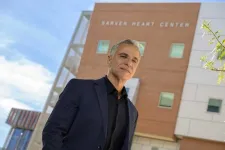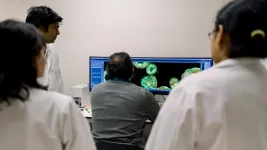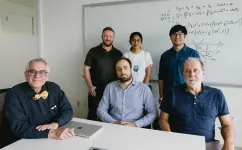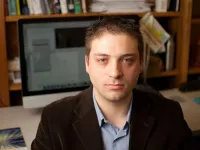(Press-News.org) A research team co-led by a physician-scientist at the University of Arizona College of Medicine – Tucson’s Sarver Heart Center found that a subset of artificial heart patients can regenerate heart muscle, which may open the door to new ways to treat and perhaps someday cure heart failure. The results were published in the journal Circulation.
According to the Centers for Disease Control and Prevention, heart failure affects nearly 7 million U.S. adults and is responsible for 14% of deaths per year. There is no cure for heart failure, though medications can slow its progression. The only treatment for advanced heart failure, other than a transplant, is pump replacement through an artificial heart, called a left ventricular assist device, which can help the heart pump blood.
“Skeletal muscle has a significant ability to regenerate after injury. If you’re playing soccer and you tear a muscle, you need to rest it, and it heals,” said Hesham Sadek, MD, PhD, director of the Sarver Heart Center and chief of the Division of Cardiology at the U of A College of Medicine – Tucson’s Department of Medicine. “When a heart muscle is injured, it doesn’t grow back. We have nothing to reverse heart muscle loss.”
Sadek led a collaboration between international experts to investigate whether heart muscles can regenerate. The study was funded through a grant awarded to Sadek by the Leducq Foundation Transatlantic Networks of Excellence Program, which brings together American and European investigators to tackle big problems.
The project began with tissue from artificial heart patients provided by colleagues at the University of Utah Health and School of Medicine led by Stavros Drakos, MD, PhD, a pioneer in left ventricular assist device-mediated recovery.
Jonas Frisén, MD, PhD, and Olaf Bergmann, MD, PhD, of the Karolinska Institute in Stockholm, led teams in Sweden and Germany and used their own innovative method of carbon dating human heart tissue to track whether these samples contained newly generated cells.
The investigators found that patients with artificial hearts regenerated muscle cells at more than six times the rate of healthy hearts.
“This is the strongest evidence we have, so far, that human heart muscle cells can actually regenerate, which really is exciting, because it solidifies the notion that there is an intrinsic capacity of the human heart to regenerate,” Sadek said. “It also strongly supports the hypothesis that the inability of the heart muscle to ‘rest’ is a major driver of the heart’s lost ability to regenerate shortly after birth. It may be possible to target the molecular pathways involved in cell division to enhance the heart’s ability to regenerate.”
Finding better ways to treat heart failure is a top priority for Sadek and the Sarver Heart Center. This study builds on Sadek’s prior research into rest and heart muscle regeneration.
In 2011, Sadek published a paper in Science showing that while heart muscle cells actively divide in utero, they stop dividing shortly after birth to devote their energy to pumping blood through the body nonstop, with no time for breaks.
In 2014, he published evidence of cell division in patients with artificial hearts, hinting that their heart muscle cells might have been regenerating.
These findings, combined with other research teams’ observations that a minority of artificial heart patients could have their devices removed after experiencing a reversal of symptoms, led him to wonder if the artificial heart provides cardiac muscles the equivalent of bedrest in a person recovering from a soccer injury.
“The pump pushes blood into the aorta, bypassing the heart,” he said. “The heart is essentially resting.”
Sadek’s previous studies indicated that this rest might be beneficial for the heart muscle cells, but he needed to design an experiment to determine whether patients with artificial hearts were actually regenerating muscles.
“Irrefutable evidence of heart muscle regeneration has never been shown before in humans,” he said. “This study provided direct evidence.”
Next, Sadek wants to figure out why only about 25% of patients are “responders” to artificial hearts, meaning that their cardiac muscle regenerates.
“It’s not clear why some patients respond and some don’t, but it’s very clear that the ones who respond have the ability to regenerate heart muscle,” he said. “The exciting part now is to determine how we can make everyone a responder, because if you can, you can essentially cure heart failure. The beauty of this is that a mechanical heart is not a therapy we hope to deliver to our patients in the future – these devices are tried and true, and we’ve been using them for years.”
END
Can the heart heal itself? New study says it can
An international research team found evidence that heart muscle can regenerate after heart failure in some people with artificial hearts
2024-12-20
ELSE PRESS RELEASES FROM THIS DATE:
Microscopic discovery in cancer cells could have a big impact
2024-12-20
In 2022 alone, over 20 million people were diagnosed with cancer, and nearly 10 million died from the disease, according to the World Health Organization. While the reaches of cancer are massive, the answer to more effective treatments may be hidden within a microscopic cell.
Led by Texas A&M University graduate students Samere Zade of the biomedical engineering department and Ting-Ching Wang of the chemical engineering department, an article released by the Lele Lab has uncovered new details about the mechanism behind cancer progression.
Published in Nature Communications, the article ...
Rice researchers take ‘significant leap forward’ with quantum simulation of molecular electron transfer
2024-12-20
Researchers at Rice University have made a meaningful advance in the simulation of molecular electron transfer — a fundamental process underpinning countless physical, chemical and biological processes. The study, published in Science Advances, details the use of a trapped-ion quantum simulator to model electron transfer dynamics with unprecedented tunability, unlocking new opportunities for scientific exploration in fields ranging from molecular electronics to photosynthesis.
Electron transfer, critical to processes such as cellular respiration and energy harvesting ...
Breakthrough new material brings affordable, sustainable future within grasp
2024-12-20
HOUSTON, Dec. 20, 2024 –While lithium-ion batteries have been the go-to technology for everything from smartphones and laptops to electric cars, there are growing concerns about the future because lithium is relatively scarce, expensive and difficult to source, and may soon be at risk due to geopolitical considerations. Scientists around the world are working to create viable alternatives.
An international team of interdisciplinary researchers, including the Canepa Research Laboratory at the University of Houston, has developed a new type of material for sodium-ion batteries that could ...
How everyday activities inside your home can generate energy
2024-12-20
Passive interfaces, such as light switches or doorknobs, refer to hardware that can store energy, but the energy can only be used for the purpose it was intended. However, research is imagining new ways for that energy to be harvested and adapted — turning your doorknob could power your alarm system or opening your freezer could turn on your kitchen light.
By integrating smart capabilities such as sensing and energy harvesting, Dr. Jeeeun Kim is transforming passive interfaces into adaptive interfaces, altering hardware to be used ...
Inequality weakens local governance and public satisfaction, study finds
2024-12-20
Local governments in developing countries are crucial for providing public services that promote human development and address challenges like extreme weather, unemployment and crumbling infrastructure. Yet, they often face difficulties in implementing cost-effective programs that meet citizens’ diverse needs, particularly in areas with significant socioeconomic inequalities.
A recent study, published in World Development and led by University of Notre Dame researcher Krister Andersson, explored the impact of economic and social inequalities on local government performance in Chile (a country with very high socioeconomic ...
Uncovering key molecular factors behind malaria’s deadliest strain
2024-12-20
RIVERSIDE, Calif. -- Nearly half the world’s population lives in regions where malaria is endemic, with the parasite Plasmodium falciparum accounting for approximately 95% of malaria-related deaths globally. Now, a new research project funded by the National Institutes of Health and led by a malaria expert at the University of California, Riverside aims to uncover the molecular factors that govern gene regulation and chromatin organization in P. falciparum, with a particular focus on long non-coding RNAs, or lncRNAs.
Chromatin is a combination of DNA and proteins that makes up the chromosomes in the cells of humans and other higher organisms.
“Malaria ...
UC Davis researchers help decode the cause of aggressive breast cancer in women of color
2024-12-20
Triple-negative breast cancer (TNBC) is an aggressive breast cancer. It spreads quickly and has few treatment options. It is also serious because of its rate of recurrence.
Black women are twice as likely as white women to be diagnosed with TNBC. They are also more likely to die from the devastating disease. In fact, the five-year survival rate for TNBC in Black women is only 14% compared to 36% in women from other racial backgrounds.
Multiple biological and socioeconomic factors are blamed for this higher risk. UC Davis Comprehensive Cancer Center researcher Sanchita Bhatnagar and her team have ...
Researchers discovered replication hubs for human norovirus
2024-12-20
Human norovirus, a positive-strand RNA virus that is the leading cause of viral gastroenteritis accounting for an estimated 685 million cases and approximately 212,000 deaths globally per year, has no approved vaccines or antivirals. Paving the way for improved drug therapies, researchers at Baylor College of Medicine and the University of Texas, MD Anderson Cancer Center report in Science Advances the discovery of replication hubs for human norovirus, which could lead to designing antiviral drugs to prevent, control or treat these infections.
“When viruses infect cells, they usually create specialized compartments ...
SNU researchers develop the world’s most sensitive flexible strain sensor
2024-12-20
◦ Seoul National University College of Engineering announced that a research team led by Prof. Seung-Kyun Kang from the Department of Materials Science and Engineering at Seoul National University (first authors: Dr. Jae-Hwan Lee and Ph.D. candidate Yoon-Nam Kim) has developed a strain sensor with record-breaking sensitivity in collaboration with researchers from Dankook University, Ajou University, and Purdue University. This groundbreaking study introduced an hypersensitive, flexible, and stretchable ...
Tiny, wireless antennas use light to monitor cellular communication
2024-12-20
CAMBRIDGE, MA – Monitoring electrical signals in biological systems helps scientists understand how cells communicate, which can aid in the diagnosis and treatment of conditions like arrhythmia and Alzheimer’s.
But devices that record electrical signals in cell cultures and other liquid environments often use wires to connect each electrode on the device to its respective amplifier. Because only so many wires can be connected to the device, this restricts the number of recording sites, limiting ...
LAST 30 PRESS RELEASES:
New study overturns long-held model of how plants coordinate immune responses.
New AI model predicts disease risk while you sleep
Scientists discover molecular ‘reshuffle’ and crack an 80-year-old conundrum
How stressors during pregnancy impact the developing fetal brain
Electrons lag behind the nucleus
From fungi to brain cells: one scientist's winding path reveals how epigenomics shapes neural destiny
Schizophrenia and osteoporosis share 195 genetic loci, highlighting unexpected biological bridges between brain and bone
Schizophrenia-linked genetic variant renders key brain receptor completely unresponsive to both natural and therapeutic compounds
Innovative review reveals overlooked complexity in cellular energy sensor's dual roles in Alzheimer's disease
Autism research reframed: Why heterogeneity is the data, not the noise
Brazil's genetic treasure trove: supercentenarians reveal secrets of extreme human longevity
The (metabolic) cost of life
CFRI special issue call for papers: New Frontiers in Sustainable Finance
HKU Engineering scholar demonstrates the smallest all-printed infrared photodetectors to date
Precision empowerment for brain "eavesdropping": CAS team develops triple-electrode integrated functional electrode for simultaneous monitoring of neural signals and chemical transmitters during sleep
Single-capillary endothelial dysfunction resolved by optoacoustic mesoscopy
HKU three research projects named among ‘Top 10 Innovation & Technology News in Hong Kong 2025’ showcasing excellence in research and technology transfer
NLRSeek: A reannotation-based pipeline for mining missing NLR genes in sequenced genomes
A strand and whole genome duplication–aware collinear gene identification tool
Light storage in light cages: A revolutionary approach to on-chip quantum memories
Point spread function decoupling in computational fluorescence microscopy
BacPhase: Long-insert paired-end sequencing for bin marker construction and genome phasing
GmWOX1 regulates the mediolateral polarity of compound leaves in soybean
ChargeFabrica: An open-source simulation tool that aims to accelerate search for high performance perovskite solar cells
High levels of ADAR overexpression induce abundant and stochastic off-target RNA editing in rice protoplasts
On-demand upgraded recycling of polyethylene and construction of sustainable multifunctional materials based on the "LEGO" strategy
New "Stomata in-sight" system allows scientists to watch plants breathe in real-time
Anorexia nervosa may result in long-term skeletal muscle impairment
Narrative-based performance reviews deemed fairest by employees
New insights reveal how advanced oxidation can tackle emerging water pollutants
[Press-News.org] Can the heart heal itself? New study says it canAn international research team found evidence that heart muscle can regenerate after heart failure in some people with artificial hearts





